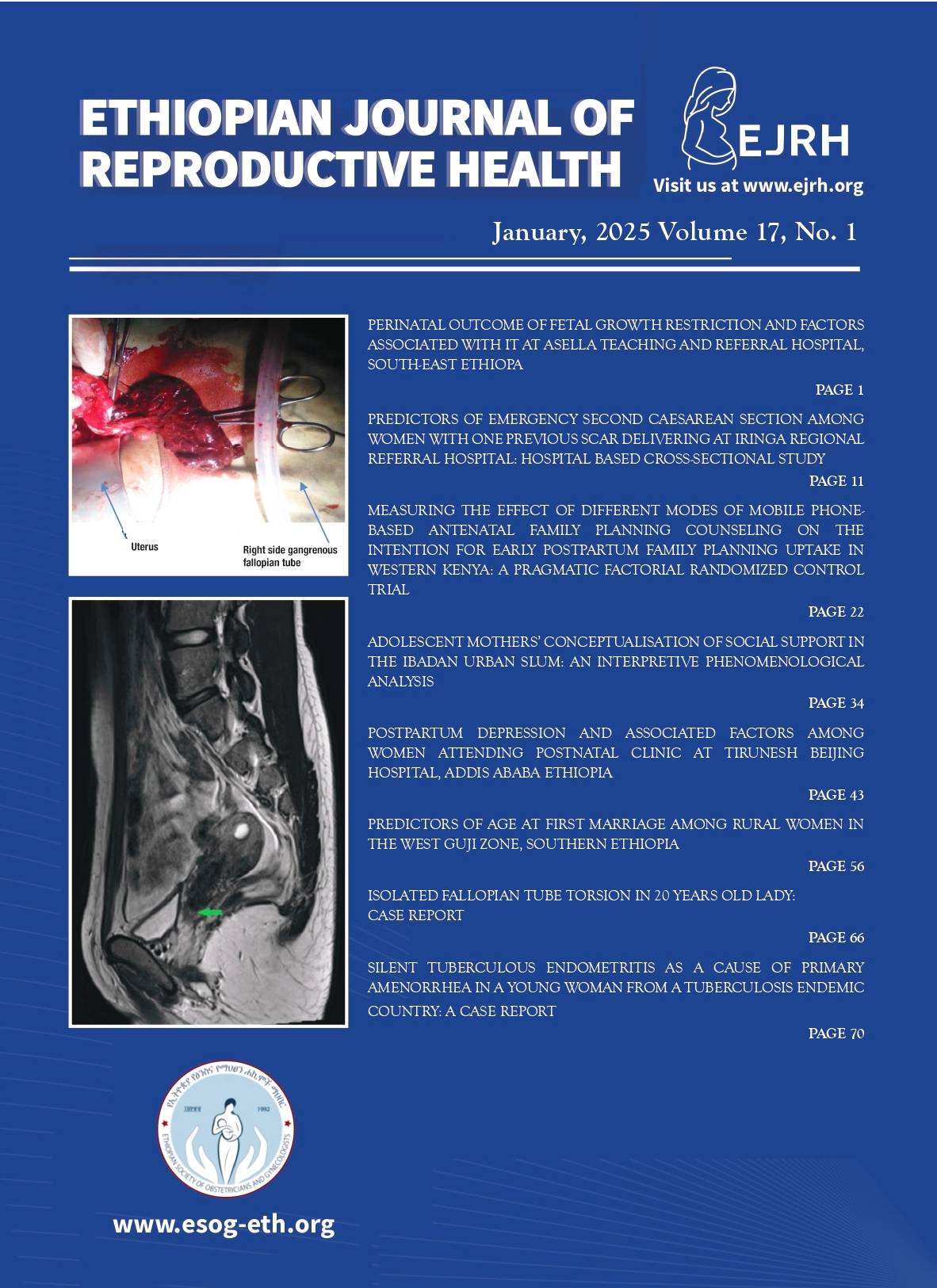Predictors of emergency second caesarean section among women with one previous scar delivering at Iringa regional referral hospital 2024
##plugins.themes.bootstrap3.article.main##
Abstract
Background: A significant increase in second-emergency caesarean sections (CS) is associated with numerous adverse obstetric outcomes. Women have the opportunity to undergo a planned childbirth, potentially preventing the need for a second emergency caesarean section. This study aims to assess the predictors of second-emergency CS
Objective: To determine the predictors of the emergency second caesarean section among pregnant women delivering at Iringa Referral Hospital
Methodology: The study was conducted at Iringa Hospital over six months using a cross-sectional design. We recruited participants using a designed checklist. We sequentially enrolled women arriving for delivery with one previous scar until we reached the target sample size. Females with medical conditions were excluded.
Results: The emergency second CS was 204(57.46%. The significant predictors of emergency second CS were lack of employment. [AOR=3.018, 95% CI (1.589, 15.461), P=0.0150]. late booking11-20 weeks [AOR=4.693, 95% CI (1.182, 18.635), P=0.0280] and >21 weeks [AOR=6.533, 95% CI (1.024, 41.667), P=0.047, category of health care provider [AOR=3.876, 95% CI (1.302, 11.535), P=0.0149]. All who had birth plan has lower chance of emergency second CS [AOR=0.005,95%CI(0.001,<0.0001) p<0.0001].Another predictors was Ultrasound scanning in last trimester [AOR=10.051, 95% CI (3.946, 25.602), P=0.0001]and pregnancy interval increase the chance of second CS [AOR=10.051, 95% CI (3.946, 25.602), P=0.0001]
Conclusion
Emergency second-caesarean sections (CS) are a more prevalent practice. Most women originate from primary healthcare centers, where nurses primarily manage them without a birth plan. Antenatal visits and delayed prenatal care were the challenges that exacerbated the situation.
KEY WORDS. predictors, emergency, second Caesarean section, previous scar, Iringa.
##plugins.themes.bootstrap3.article.details##
##plugins.themes.bootstrap3.article.details##
predictors, emergency, second caesarean section, Iringa
2. Grabarz A, Ghesquière L, Debarge V, Ramdane N, Delporte V, Bodart S, et al. Title: Cesarean section complications according to degree of emergency during labour. 2020.
3. Betran AP, Ye J, Moller AB, Souza JP, Zhang J. Trends and projections of caesarean section rates: Global and regional estimates. BMJ Glob Heal. 2021 Jun 15;6(6).
4. Gaffur R, Mchome B, Ndaninginan LL, Asubiojo B, Mahande MJ, Maro E. Association between first birth caesarean delivery and adverse maternal-perinatal outcomes in the second pregnancy: a registry-based study in Northern Tanzania. BMC Pregnancy Childbirth. 2022 Dec 1;22(1).
5. Jamshed S, Chien SC, Tanweer A, Asdary RN, Hardhantyo M, Greenfield D, et al. Correlation Between Previous Caesarean Section and Adverse Maternal Outcomes Accordingly With Robson Classification: Systematic Review and Meta-Analysis. Vol. 8, Frontiers in Medicine. Frontiers Media S.A.; 2022.
6. Kongwattanakul K, Thamprayoch R, Kietpeerakool C, Lumbiganon P. Risk of Severe Adverse Maternal and Neonatal Outcomes in Deliveries with Repeated and Primary Cesarean Deliveries versus Vaginal Deliveries: A Cross-Sectional Study. J Pregnancy. 2020;2020.
7. Royal College of Obstetrics Gynecology. BIRTH PLAN AFTER PREVIOUS CAESAREAN SECTION. 45th ed. Vol. NO 45. Royal Cllege of Obstetrics and Gynecology; 2015. 2–18 p.
8. ACOG. planned mode of delivery after one previous scar.
9. Kaboré C, Chaillet N, Kouanda S, Bujold E, Traoré M, Dumonta A. Maternal and perinatal outcomes associated with a trial of labour after previous caesarean section in sub-saharan countries. BJOG An Int J Obstet Gynaecol. 2016 Dec 1;123(13):2147–55.
10. Wankaew N, Jirapradittha J, Kiatchoosakun P. Neonatal morbidity and mortality for repeated cesarean section vs. normal vaginal delivery to uncomplicated term pregnancies at Srinagarind hospital. J Med Assoc Thail. 2013;96(6):654–60.
11. Bishop D, Dyer RA, Maswime S, Rodseth RN, van Dyk D, Kluyts HL, et al. Maternal and neonatal outcomes after caesarean delivery in the African Surgical Outcomes Study: a 7-day prospective observational cohort study. Lancet Glob Heal. 2019 Apr 1;7(4):e513–22.
12. RWEYEMAMU M. PREDICTORS AND OUTCOMES OF WOMEN ATTEMPTING VAGINAL BIRTH AFTER CESAREAN DELIVERY AT IRINGA REGIONAL REFERRAL HOSPITAL MARIA ANGELICA RWEYEMAMU MASTER OF MEDICINE IN OBSTETRICS AND GYNECOLOGY. DODOMA; 2018.
13. Kalisa R, Rulisa S, van Roosmalen J, van den Akker T. Maternal and perinatal outcome after previous caesarean section in rural Rwanda. BMC Pregnancy Childbirth. 2017 Aug 25;17(1).
14. Osayande I, Ogunyemi O, Gwacham-Anisiobi U, Olaniran A, Yaya S, Banke-Thomas A. Prevalence, indications, and complications of caesarean section in health facilities across Nigeria: a systematic review and meta-analysis. Vol. 20, Reproductive Health. BioMed Central Ltd; 2023.
15. Karim F, Ali NB, Khan ANS, Hassan A, Hasan MM, Hoque DME, et al. Prevalence and factors associated with caesarean section in four hard-to-reach areas of Bangladesh: Findings from a cross-sectional survey. Vol. 15, PLoS ONE. Public Library of Science; 2020.
16. Taye MG, Nega F, Belay MH, Kibret S, Fentie Y, Addis WD, et al. Prevalence and factors associated with caesarean section in a comprehensive specialized hospital of Ethiopia: A cross-sectional study; 2020. Ann Med Surg. 2021 Jul 1;67.
17. Sovio U, Smith GCS. Blinded ultrasound fetal biometry at 36 weeks and risk of emergency Cesarean delivery in a prospective cohort study of low-risk nulliparous women. Ultrasound Obstet Gynecol. 2018;52(1):78–86.
18. Ahmadpour P, Moosavi S, Mohammad-Alizadeh-Charandabi S, Jahanfar S, Mirghafourvand M. Effect of implementing a birth plan on maternal and neonatal outcomes: a randomized controlled trial. BMC Pregnancy Childbirth. 2022 Dec 1;22(1).
19. Patel MD, Maitra N, Patel PK, Sheth T, Vaishnav P. Predicting Successful Trial of Labor After Cesarean Delivery: Evaluation of Two Scoring Systems. J Obstet Gynecol India. 2018 Aug 1;68(4):276–82.
20. Siddiqui SA. Obstetric factors for unsuccessful trial of labor in second-order birth following previous cesarean. Ann Saudi Med. 2013 Jul;33(4):356–62.
21. Attanasio LB, Kozhimannil KB, Kjerulff KH. Women’s preference for vaginal birth after a first delivery by cesarean. Birth. 2019 Mar 1;46(1):51–60.
22. Mascarello KC, Matijasevich A, Barros AJD, Santos IS, Zandonade E, Silveira MF. Repeat cesarean section in subsequent gestation of women from a birth cohort in Brazil. Reprod Health. 2017 Aug 25;14(1).




